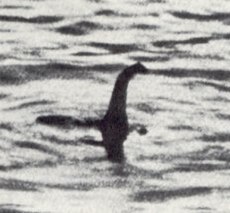This day in history: The "Surgeon's Photograph", the most famous photo allegedly showing the Loch Ness Monster, is published in the Daily Mail on this day in 1934.
From Wikipedia:
The "surgeon's photograph" is reportedly the first photo of the creature's head and neck. Supposedly taken by Robert Kenneth Wilson, a London gynaecologist, it was published in the Daily Mail on 21 April 1934. Wilson's refusal to have his name associated with it led to it being known as the "surgeon's photograph". According to Wilson, he was looking at the loch when he saw the monster, grabbed his camera and snapped four photos. Only two exposures came out clearly; the first reportedly shows a small head and back, and the second shows a similar head in a diving position. The first photo became well known, and the second attracted little publicity because of its blurriness.
For 60 years, the photo was considered evidence of the monster's existence, although skeptics dismissed it as driftwood, an elephant, an otter or a bird. The photo's scale was controversial; it is often shown cropped (making the creature seem large and the ripples like waves), while the uncropped shot shows the other end of the loch and the monster in the centre. The ripples in the photo were found to fit the size and pattern of small ripples, rather than large waves photographed up close. Analysis of the original image fostered further doubt. In 1993, the makers of the Discovery Communications documentary Loch Ness Discovered analyzed the uncropped image and found a white object visible in every version of the photo (implying that it was on the negative). It was believed to be the cause of the ripples, as if the object was being towed, although the possibility of a blemish on the negative could not be ruled out. An analysis of the full photograph indicated that the object was small, about 2 to 3 foot long.
Since 1994, most agree that the photo was an elaborate hoax. It had been described as fake in a 7 December 1975 Sunday Telegraph article that fell into obscurity. Details of how the photo was taken were published in the 1999 book, Nessie – the Surgeon's Photograph Exposed, which contains a facsimile of the 1975 Sunday Telegraph article. The creature was reportedly a toy submarine built by Christian Spurling, the son-in-law of Marmaduke Wetherell. Spurling admitted the photograph was a hoax in January 1991. Wetherell had been publicly ridiculed by his employer, the Daily Mail, after he found "Nessie footprints" that turned out to be a hoax. To get revenge on the Mail, Wetherell perpetrated his hoax with co-conspirators Spurling (sculpture specialist), Ian Wetherell (his son, who bought the material for the fake), and Maurice Chambers (an insurance agent). The toy submarine was bought from F. W. Woolworth, and its head and neck were made from wood putty. After testing it in a local pond the group went to Loch Ness, where Ian Wetherell took the photos near the Altsaigh Tea House. When they heard a water bailiff approaching, Duke Wetherell sank the model with his foot and it is "presumably still somewhere in Loch Ness". Chambers gave the photographic plates to Wilson, a friend of his who enjoyed "a good practical joke". Wilson brought the plates to Ogston's, an Inverness chemist, and gave them to George Morrison for development. He sold the first photo to the Daily Mail, who then announced that the monster had been photographed.
Little is known of the second photo; it is often ignored by researchers, who believe its quality too poor and its differences from the first photo too great to warrant analysis. It shows a head similar to the first photo, with a more turbulent wave pattern, and possibly taken at a different time and location in the loch. Some believe it to be an earlier, cruder attempt at a hoax, and others (including Roy Mackal and Maurice Burton) consider it a picture of a diving bird or otter that Wilson mistook for the monster. According to Morrison, when the plates were developed, Wilson was uninterested in the second photo; he allowed Morrison to keep the negative, and the photo was rediscovered years later. When asked about the second photo by the Ness Information Service Newsletter, Spurling "... was vague, thought it might have been a piece of wood they were trying out as a monster, but [was] not sure."
Buy : Halloween and the Strange in Story and History for 99 cents (50 Chapters) and Buy this Kindle book on Amazon on Vampires and Werewolves for only 1.99




No comments:
Post a Comment